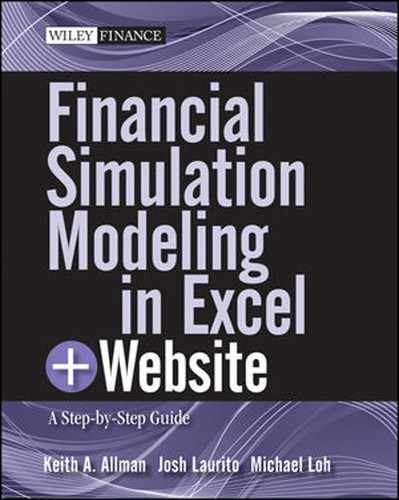Preface
Regardless of where I work, simulation has crept into my financial career. After nearly a decade of working with it in many capacities I've found it to be a mixed blessing. In many investment companies when the term simulation is simply brought up there are a variety of reactions. The two most visible camps of thought seem to be the utilizers, who think the results of a simulation have value and the skeptics, who think simulation overcomplicates analyses.
The utilizers believe that when a concept or instrument is researched correctly, information parsed and calculated properly, and a simulation constructed in a statistically correct manner, the results can be used to make decisions. I tend to fall into this camp, with a few caveats I will mention later, because I have seen its utility in a variety of settings. Infrastructure deals that I saw early in my career that involved vehicular traffic, trade, or passenger flows, made more sense through simulation results given the wide variety of scenarios that could play out over time. A commodity company investment that I worked on at Citigroup involving soybeans seemed more appropriate after seeing the historic volatility of soybean prices and how their expected evolution might affect our exposure. In my structured finance career, the value of simulation on a very granular level for distressed mortgage-backed securities provided insight into obligor delinquency, default, and eventually expected security value loss. More recently, as I moved into private equity, simulating pools of corporate exposures and fund performance has become an important tool in assessing portfolio risk.
With all of these positives, there are some valid criticisms of simulation that are espoused by the skeptics. Relating to the overcomplication arguments is the thought that simulation is complex and that many mistakes can be made. I agree with this criticism, and one of the caveats that I alluded to earlier is that simulation must be implemented correctly for it to be useful and productive. I have seen simulations fail for a number of reasons, but most relate to poor implementation. In one transaction that I saw taken to a credit committee, the simulation implemented was purely derived from Excel's random number generator creating numbers based on a uniform distribution. No analysis was done around the appropriate distribution, and the CEO, who had an actuary background, instantly criticized the presentation.
In another transaction at an investment bank, a transaction specialist asked me to use a third-party simulation program to assist in modeling a structured product. I used the model exactly as it was intended and provided the results to the specialist. I knew that the time frame for the transaction was limited, but I was surprised that later in the day the specialist was preparing the results to use for the investment committee. The results that he had were a simulation of the asset side only and had no bearing on the liability structure being implemented. Trying to use such results in the manner he intended would have been erroneous. Luckily, the problem was caught in time and the proper analysis later done.
Even worse are systemic failures of simulation that we have recently seen. Before the 2007/2008 global financial crisis, the market assumed a lower correlation level for mortgage-backed securities than was actually intrinsic to the system. Simulations were run, and securities were poorly sized against default partly relating to this correlation underestimation. As the crisis evolved, the correlations were rerun and noticeably higher, meaning that the securities structured via simulations using lower correlations were much riskier than originally thought.
The intent of exposing my negative experiences with simulation is by no means to dissuade readers from using it and therefore throwing into question what the many pages that follow this preface could possibly be about. The purpose is to show that many of the problems related to financial simulation are caused by improper construction, use, or interpretation. Historical data that provides probabilities, volatility, or correlations might not be scrubbed and analyzed correctly, the implementation of simulation methods might be against the wrong distribution or structurally incorrect, and interpretation of results could be construed to arrive at fallacious conclusions.
The problems seem surmountable when enough time is taken to use simulation correctly. To be able to do this in a financial context, many people encounter difficulties because the bulk of the texts that explain simulation methodologies are extremely dense and theoretical. Few try to distill the important concepts into a readily accessible format with meaningful and practical examples. Like the other books in my step-by-step series, this book attempts to bridge the gap between basic technical implementation and purely theoretical explanations.
A noticeable difference with this book compared to my others is the appearance of two other names on the cover: Michael Loh and Josh Laurito. Simulation is a highly complex topic, and to thoroughly dig into the details their unique experiences and abilities were absolutely necessary. Michael's technical background in physics and finance brings a high mathematical acumen, which is reflected in the most difficult Model Builders seen on the website and throughout many sections of the text. Josh has deep industry experience and firsthand experience using simulation in a variety of contexts on Wall Street. Frequently we will use the terms “I” and “we” throughout the book. In both cases we are referring to all three of us from a collective perspective.
It's my belief that the combination of our skills and experience has been conveyed in an approachable, unintimidating, and clear manner. I hope that the pedagogical approach allows readers to walk away with a new tool in their analytical skill set and a feeling of personal value addition. If readers feel that something is still not clear or that they have found a possible typo or error, I encourage them to check the book's website for errata or to contact me personally at [email protected].
Keith Allman
